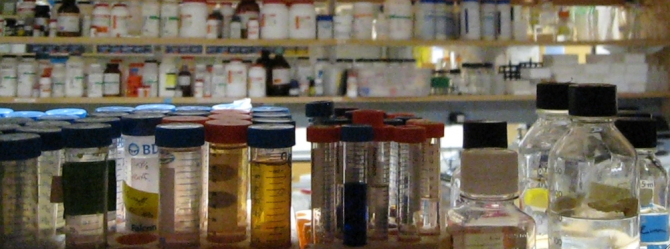Difference between revisions of "20.109(S08):Site-directed mutagenesis (Day2)"
(→Part 2: site-directed mutagenesis) |
(→Part 2: site-directed mutagenesis) |
||
| Line 22: | Line 22: | ||
#Finally, add 1 μL of ''PfuTurbo'' DNA polymerase to each reaction. | #Finally, add 1 μL of ''PfuTurbo'' DNA polymerase to each reaction. | ||
#Once each group is ready, we will begin the thermocycler, under the following conditions: | #Once each group is ready, we will begin the thermocycler, under the following conditions: | ||
| + | |||
<center> | <center> | ||
| Line 40: | Line 41: | ||
| 30 sec | | 30 sec | ||
|- | |- | ||
| − | |||
| − | |||
| 55 | | 55 | ||
| 1 min | | 1 min | ||
Revision as of 20:12, 13 December 2007
Contents
Introduction
Protocols
Part 1: primer preparation
- Calculate the amount of water needed for each primer to give a concentration of 1 ng/mL.
- Touch-spin your primers, resuspend each in the appropriate volume of water, and touch-spin again.
- Calculate the dilution of primer that you need to prepare in order to have 125 ng present in 2.5 μL. Prepare 100-200 μL of this dilution and keep it on ice.
Part 2: site-directed mutagenesis
We will be using the QuickChange® kit from Stratagene to perform our site-directed mutageneses. Each group will set up three reactions and associated controls. You should work quickly but carefully, and keep your tubes in a chilled container at all times.
- Read through the following protocol and prepare all calculations before beginning physical manipulations of your samples.
- You will be given an X μL mixture that contains buffer and dNTPs when you are ready to begin. Aliquot 40 μL per tube.
- Add 2 μL of template DNA (“IPC plasmid”) to each of your three reaction tubes. Do not add template to your control tubes!
- Note: mutagenesis reactions are expected to run smoothly with 5-50 ng of plasmid DNA. You have been given a 1:200 dilution of miniprep DNA.
- Increase the volume of each reaction to 50 μL by adding the appropriate amount of water (note: this amount is different for sample versus control reactions).
- Finally, add 1 μL of PfuTurbo DNA polymerase to each reaction.
- Once each group is ready, we will begin the thermocycler, under the following conditions:
| Segment | Cycles | Temperature (° C) | Time |
|---|---|---|---|
| 1 | 1 | 95 | 30 sec |
| 2 | 18 | 95 | 30 sec |
| 55 | 1 min | ||
| 68 | 5 min | ||
| 3 | 1 | 4 | indefinite |
- After the cycling is completed, each group should add 1 μL of DpnI per tube. Samples will be incubated for one hour at 37 C. You will be asked to consider why in your homework assignments.
- This final incubation step will take us past lab closing time, at which point the teaching staff will take over. Each reaction will be transformed into XL1-Blue competent cells under delicate conditions.(* define procedure in note below)
- Tomorrow, two candidate colonies will be chosen from each plate. The efficiency of this mutagenesis protocol is reported to be 80%. We will sequence two candidates per mutation to cover our bases, so to speak.
Part 3: prepare tubes for liquid O/N cultures
You will make your teaching staff very happy if you contribute to their preparatory work. Please prepare 6 tubes each containing 2.5 mL LB and 1:1000 Amp/Cam.
Part 4: journal article discussion
During the production of the mutagenized DNA, we will discuss the following journal article (link). The purpose of this discussion will be two-fold: 1) to familiarize ourselves with the history of our protein of interest ??and/or?? the state-of-the-art in protein design, 2) to explore ways of talking about the scientific literature.
